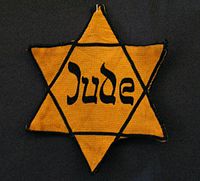Faux Hebrew
Faux Hebrew is a Latin script typeface that mimics the calligraphic curves and large serif of Hebrew characters.[1] The style is used for decorative purposes, such as in artwork, foreign branding advertisements, and antisemitic propaganda, often to evoke themes of Jewishness or represent Israel.
In some cases, actual Hebrew letters are substituted for Latin letters. For example, the alef א is used for X, shin ש is used for W, and samekh ס is used for O,
The first Faux Hebrew typeset was Papirtis Maseltov, created in 1963 by Charles Papirtis.[2]
Criticism[edit]
Like other typefaces that mimic non-Latin characters, the use of Faux Hebrew has been a subject of criticism. Some view the use of Faux Hebrew script as appropriating Jewish culture without understanding its historical or religious significance.
Jessica Helfand in a 2007 Design Observer essay compared using Faux Hebrew to Don Imus's comments on the Rutgers women's basketball team stating, "what's the difference between a celebrity making an unforgivable racist remark and a typographer making a font that clumsily perpetuates a cultural stereotype."[3] Professor Sarah Bunin Benor rejected book cover design that used Faux Hebrew stating, “it’s just not appropriate because it has this mocking or comedic effect.'”[2]
See also[edit]
References[edit]
- ^ BENOR, SARAH BUNIN (2009). "Do American Jews Speak a "Jewish Language"? A Model of Jewish Linguistic Distinctiveness". The Jewish Quarterly Review. 99 (2): 230–269. ISSN 0021-6682. JSTOR 40586715.
- ^ a b Silverstein, Andrew (2022-07-22). "In the rarified world of Jewish letters, a mind-boggling font of Jewish history". The Forward. Retrieved 2023-03-24.
- ^ "Why Is This Font Different From All Other Fonts?". Design Observer. Retrieved 2023-03-25.

